Chapter 15. City of London: Sir John Cass Business School
What Is It?
The Sir John Cass Business School is a research-intensive international school ranked in the top 50 institutions worldwide for MBA education. The school enrolls some 2,800 overwhelmingly postgraduate students who study exclusively in a new building; undergraduates normally study at the main university campus. The new building, which opened in May 2003, lies in the heart of London's central financial district, The City. The building has seven floors plus a basement. (See Figure 1.) Built in the shape of a letter B, it has two relatively small atriums, one four stories high and the other six stories, designed to provide light and to support the natural ventilation system. (See Figure 2.)
Figure 1. Cass Business School (a) Front Entrance and (b) North Side
(a)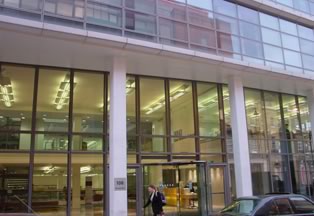
(b)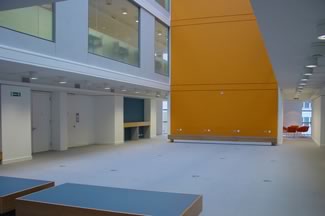
Figure 2. Cass Business School (a) East Atrium and (b) West Atrium
(a)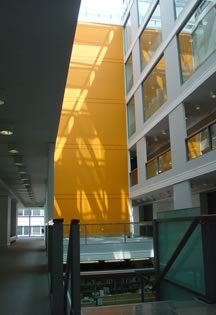
(b)
With the benefit of hindsight, one of the major advantages of the design process was the exceedingly long time it took to find both a site and the financial resources for the new building. This time was productively used in researching the requirements of a flexible 21st-century learning space that would serve the needs of both students and the business communities in and beyond London.
What Happens Here?
The building houses the full, self-contained range of administrative, academic, research, and teaching and learning functions. The lower ground floor houses two 60-seat classrooms with level floors and a 180-seat auditorium with near-perfect acoustics that do not require amplification. The auditorium is used intensively for large classes and, particularly in the evenings, business conferences and events. A reception area outside the auditorium?one of the most flexible multifunction spaces in the building?is used for refreshments and exhibitions. (See Figure 3.) The ground floor contains a raked, or sloping, 80-seat classroom and a high-technology securities-dealing room sponsored by Bloomberg. (See Figure 4.) With its glass wall, the classroom has high visibility from the reception area.
Figure 3. (a) Auditorium and (b) Milling Area
(a)
(b)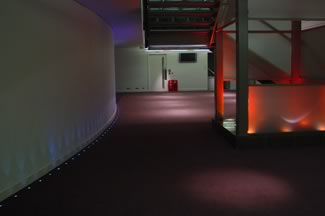
Figure 4. (a) Raked Classroom and (b) Securities Dealing Room
(a)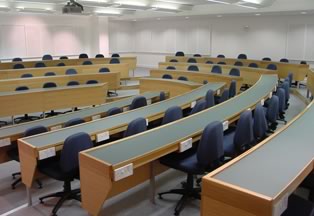
(b)
The learning resources center occupies the first floor. The high atrium above it ensures the visibility of scholarship?literally?at the heart of the school. The first floor also has two computer classrooms, a special business information room sponsored by Reuters, and a group decision-support and videoconferencing room that users can reserve. The second and third floors house the remaining 8 large classrooms and 16 team rooms. The café (on the ground floor) and restaurant (third floor) were always conceived of as part of the learning space of the building. Generous amounts of social space accommodate informal student meetings, supported with extra seats and tables in line with student demand since the building opened. (See Figure 5.)
Figure 5. (a) Learning Resources Center and (b) Café
(a)
(b)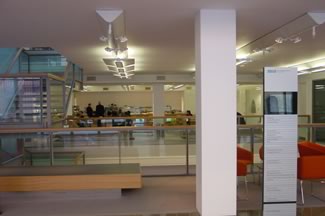
How Is Technology Used?
The building has 350 km of network wiring with more than 3,500 data points, each capable of taking voice, data, or video. Every raked classroom has power and Internet access at every seat, and power and Internet points are available in virtually all areas used by staff and students. Each classroom has a high-technology lectern, allowing full control over all audiovisual facilities. Overhead projectors have been replaced by electronic visualizers (document cameras) in all classrooms.
Unusual high-technology features distinguish Room 2001, a 60-seat classroom with a fold-down flat-screen computer beneath every desktop. (See Figure 6.) The desks can be used normally with no computer visible, and then converted in a few seconds into computer workstations simply by lifting the desktop. The lectern in this room uses Tablet PC functionality.
Figure 6. Room 2001, a Computer-Enhanced General Classroom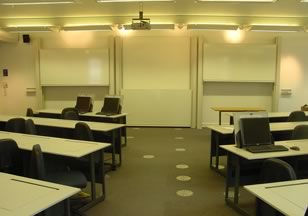
More than 30 kiosk PCs spread throughout the building enable students to check e-mail quickly. A low priority was put on wireless, since the building is one of the most intensively wired business schools in the world; however, a wireless network is being installed for use by visitors and executive education programs.
What Makes the Space Successful?
The first factor in the building's success is the diversity of the spaces. Creating such diversity was a key result of the research project that preceded the architectural design. The second factor is the close attention paid to design detail. The acoustics and lighting in particular benefited from the expertise of high-quality architects and consultants. In some cases the design uses acoustics to ensure quiet; in others, such as some public spaces, the acoustical properties of the concrete deliberately promote noise, producing a "buzz" in the building through most of the day and evening.
It proved vital that the university rejected the appointment of signature architects who might have imposed an idiosyncratic design on the school. Instead the job went to a London-based firm, Bennetts Associates, with a reputation for understanding the exact needs of the client and converting those creatively into award-winning designs that work on a day-to-day basis.
What Principles Were Behind the Design?
At the design stage, the business school reviewed its pedagogic strategy and decided on a high-tech, high-touch building. This clarified that almost every space would provide staff and students wired access to the Internet and offer opportunities for non-technology-based face-to-face interaction. The earlier research project had shown that knowledge work relies heavily on accidental meetings and discourse; workspace planning can both help and hinder such opportunities. Once this subtlety in the design requirement was clear, the architects went to great lengths to produce a diversity of spaces that would support a range of encounters, both formal and informal. This decision pedagogically to concentrate on the high-tech, high-touch combination narrowed the range of choices available and has continued to inform the updating of the facilities.
At the earliest stages, the dean of the business school mandated that the user requirements for the building be derived from a research study into global best practices to meet his vision of a "world-class temple of knowledge." At this stage?prior to the appointment of architects?visits were made to locations worldwide, including the Agora in Athens, which had successfully linked the worlds of business, government, and academic thinking. Ultimately, the single most powerful influence came from the San Marco Monastery in Florence, since almost every configuration of its space is optimized to support and stimulate knowledge work. (See Figure 7.) The Cass Business School does not look like a monastery, but its design reflects a similar diversity and quality of knowledge space.
Figure 7. Cloister-like Corridor in Learning Resource Centre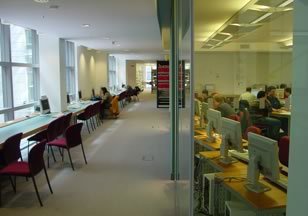
Once architects were appointed, the university made no attempt to impose a particular architectural style despite the architects' success in the mainstream modernist tradition rather than the postmodernist or any other tradition. A further round of research was carried out with visits internationally to a wide range of business schools. These visits helped identify what was disliked as much as what to copy. The visits also served as an excellent team-building exercise among the university, the architects, and the business school.
The clarity in advance thinking by the business school meant rejecting two early design schemes because they didn't fully reflect the spirit sought in the building. To the architects' credit, they continued listening. They produced a configuration that met the planning and cost constraints on the one hand and the core need to design world-class learning spaces on the other hand. The resulting building also represents an intellectual hub for the City of London.
What Is Unique or Noteworthy?
A crucial aspect of the design process was the setting up of 13 user groups involving frontline staff who had in-depth understanding of the practical space needs for their own functions. For example, a group for the front desk design (see Figure 8) involved the receptionist team, a group for the lectern design involved academics, and so on.
Figure 8. Cass Business School Lobby
The cautious and protracted research into design options before hiring the architects meant that the school had a very clear idea of the "spirit" wanted for the new building. Once the architects listened to and locked on to what this spirit really meant, they articulated that vision in elegant physical terms. The whole building is based on principles of flexibility and transparency, reflecting the values of the Sir John Cass Business School.
About the Author
Clive Holtham is professor of information management and director of the Cass Learning Laboratory at the Cass Business School, City University, in London.